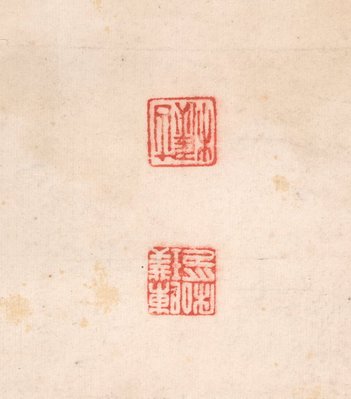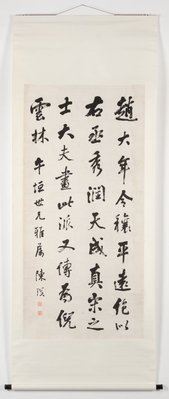

-
Details
- Place where the work was made
-
China
- Period
- Qing dynasty 1644 - 1911 → China
- Media categories
- Scroll , Calligraphy
- Materials used
- hanging scroll; ink on paper
- Dimensions
- 138.5 x 64.5 cm image; 204.5 x 86.3 cm scroll
- Signature & date
Signed l.l., in Chinese, inscribed in black ink "... Chen Pu".
Signed l.l., in Chinese, stamped in red ink “Chen Pu Shiyin [artist's seal]".
Signed l.l., in Chinese, stamped in red ink “Guqiao [artist's seal]".
Not dated.- Credit
- Gift of Dr. James Hayes 2005
- Location
- Not on display
- Accession number
- 246.2005
- Copyright
- Artist information
-
Chen Pu
Works in the collection
- Share
-
-
About
‘Pingyuan created by Zhao Danian [Zhao Lingrang, act 1070–1100] bears an exact resemblance to that of Youcheng’s [Wang Wei, 701–761] works; elegant and effortless, it is truly the painting of the Song literati. This style is then bequeathed to Ni Yunlin [Ni Zan, 1301–74].’
Inscription and signature: Written for Wuyuan as he requested. Chen Pu.The concept ‘pingyuan’ (level-distance perspective) is defined as looking from a place in the foreground over a far distance across a flat landscape. Developed by Guo Xi (c1010–90) of the Song dynasty, it is one of the three classic perspectives of traditional landscape painting which were standardised during the Tang dynasty. Zhao Lingrang was the eleventh grandson of Emperor Taizu (r960–76), founder of the Song dynasty. His landscape paintings, which are generally small and allude to views of misty rivers, made a mark on the lyrical style of the Southern Song period (1127–1279). Wang Wei was a great poet and painter of the Tang dynasty. His work, displaying an intimacy and quiet melancholy, found great favour among later literati artists. Ni Zan was one of the Four Great Masters of the Yuan period (1279–1368), praised for his landscapes painted with dry brushwork, minimal detail and a free ambience. Yet he was admired not only for the strength and refinement of his artwork, but for his personal character which many aspired to emulate.
Chen Pu was also considered an important painter and poet. Along with Li Jian (1747–1799) and Xie Lansheng (1760–1831), the three were praised as ‘sanjie’ (three outstanding painters) in Guangdong region.
‘The Poetic Mandarin: Chinese Calligraphy from the James Hayes Collection’. pg.72.
© 2005 Art Gallery of New South Wales -
Places
Where the work was made
China
-
Exhibition history
Shown in 1 exhibition
The poetic mandarin: Chinese calligraphy from the James Hayes collection, Art Gallery of New South Wales, Sydney, 23 Sep 2005–27 Nov 2005
-
Bibliography
Referenced in 1 publication
-
LIU Yang, The poetic mandarin: Chinese calligraphy from the James Hayes collection, Sydney, 2005, 72, 73 (illus.). cat.no.14
-


